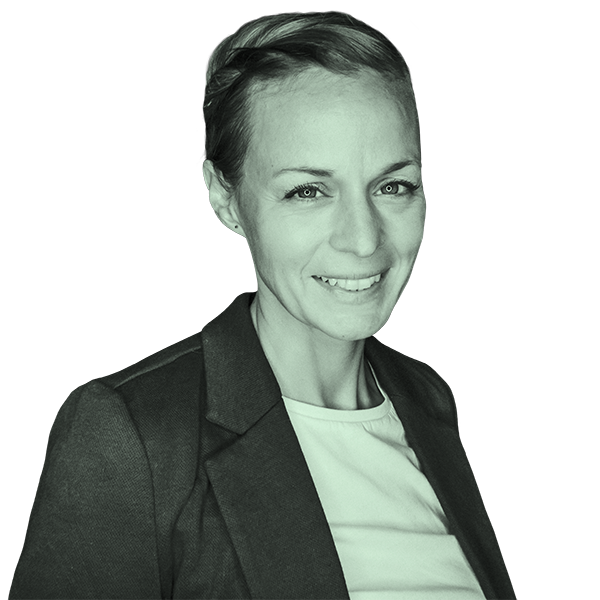Change Management –
Definition & process

Change management involves breaking old patterns to make room for new ones. But how does this process work? What methods and tools are available to change managers, what stages do organizations go through in the change process, and what exactly is the difference between change management and organizational development? We show what types of change there are, how organizations can manage change, and why managers are increasingly responsible for “unlearning” the old to make room for the new.
Content
- What is change management?
- Why change management is so important
- Change management & organizational development
- Lean change management
- What change management models are there?
- How does change management work?
- Change management – the process
- Change management – the phases
- The phases of change
- Change management with Wonderwerk
- Transformation through innovation
- Why Wonderwerk?
What is change management?
By definition, change management refers to the active management of change. This process takes place within a limited time frame and involves moving an organization from an initial state X to a clearly defined target state Y. The ultimate goal is to achieve sustainable change that is put into practice.
In order for the target state to become the new norm, it is important to strategically plan, manage, control, and stabilize the individual steps in advance. To this end, we have various methods, tools, and concepts at our disposal in change management.
Change management helps companies and organizations to
- create awareness of the need for change at all levels.
- anticipate negative reactions and respond appropriately.
- give employees a clear picture of the target state and the path to get there.
- absorb any uncertainties that arise.
Why change management is so important
Change has always been important. But while “change” ten or fifteen years ago meant time-bound leaps in innovation, today continuous structural adaptation is the basic prerequisite for companies and organizations of all sizes to remain operational and competitive. Only organizations that are able to respond flexibly to the constantly changing conditions of our modern working world can survive. The reason for this can be summed up in one word:
SCARCITY.
Efficient management in times of change
Companies go bankrupt, merge with other companies or lay off a large part of their workforce. Elsewhere, old structures are being dusted off and organizational charts thrown out. These upheavals are not evidence of an economy or administration incapable of acting, but rather the result of (economic) existence under enormous pressure. Companies and organizations in the public and/or social sector today have less
- Time: Technological progress is exponential. Companies that are at the cutting edge today may be obsolete tomorrow.
- Resources: Raw materials are becoming more expensive and harder to obtain. At the same time, political and social demands for sustainability management are growing.
- Scope for action: Stricter legal requirements tie up resources and can hamper growth (e.g., when certain certifications become mandatory).
- Security: More and more providers are competing for orders in a globalized market.
At the same time, companies must respond to their employees’ demands for a better work-life balance (see our Cornerstone on New Work) and create prospects to remain attractive as employers. Only leadership that sees change as an opportunity and transformation as a driving force can turn these challenges into successes.
For this reason, change management often goes hand in hand with new approaches to leadership (see New Leadership) and is an indispensable component of successful innovation management.
Starting points for change management
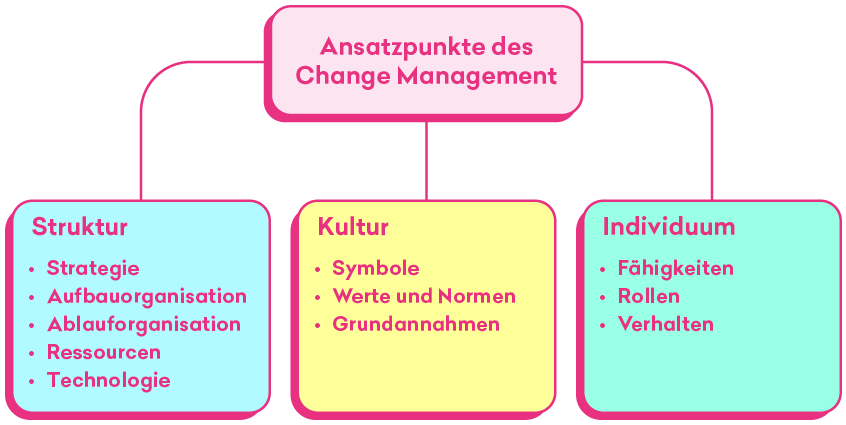
Change Management & Organisationsentwicklung
Change management has its origins in the theory of organizational development, which emerged in the United States in the 1930s. The pioneering theory of the “phases of change” goes back to Kurt Lewin.
In summary, the theory of organizational development states that increases in efficiency are achieved less through changes in working conditions and more through a stronger focus on employees.
Organizational development is therefore not aimed at a specific goal, but is a holistic, long-term approach. The aim is to optimize internal processes and structures in such a way that the economic goals of the company/organization are in harmony with the personal goals and development opportunities of the employees. Organizational development processes differ from change processes in that
- the specific change is integrated into long-term development processes.
- Employees play a key role in implementing the change.
- The goal of the change is not imposed “from above,” but is developed with the involvement of employees and adjusted as necessary.
- Employees are generally intrinsically motivated because the change is not imposed on them “from outside.”
Organizational development vs. change management
While organizational development involves the continuous adaptation and optimization of internal structures, change management involves supporting change processes that are time-limited and geared toward a specific end goal.
This goal is usually “set from above” because in many cases it arises from an economic or political necessity. Typical examples of necessary changes imposed from above include mergers between companies, the digitization of business processes, or the reorganization of departments.
| Change management | organizational development |
| Change processes that are limited in time and geared toward a specific target state. | Changes integrated into long-term development processes that do not usually pursue a fixed goal. |
| The goal of the change is normally specified “from above” because it arises from a specific need. | The goals are not predetermined but are developed with the participation of everyone in the company/organization. |
| Negative reactions such as fears and uncertainty are anticipated from the outset and those affected are supported accordingly. | Employees react predominantly positively to change because they are intrinsically motivated. |
| Change processes are often initiated, planned, and supported by consultants. | Consulting services for organizational development are available but not always necessary. |
Organizational development and agility
Involving employees in the development of the organization requires a flexible management framework. This is why more and more organizations are choosing to create the appropriate structures as part of an agile transformation and, in the process, are also introducing OKRs (Objectives and Key Results), for example. OKR breaks down the rigid top-down management approach and replaces it with a flexible bottom-up principle.
Lean change management
Classic change management and agility merge in what is known as Lean Change Management (LMC). This change management method aims to implement changes particularly quickly using the iterative approach from agility: By dividing large changes in companies and organizations into as many small steps as possible, the following advantages arise:
- Quick wins: Small goals are easier (and faster) to achieve than large ones. In lean change management, we therefore see initial successes very quickly.
- Easier correction: Continuous implementation and ongoing feedback ensure that errors are identified very early on and corrections can be implemented quickly.
- Stronger identification: By implementing a large number of small sub-projects in parallel rather than ONE large project, everyone is involved in the change process in LCM, which increases acceptance and creates a shared vision of the target state.
A good example of the lean change management approach would be the transition to a new working method, for example in the context of a transformation toward New Work.
Instead of introducing changes directly at all levels, the company starts with a small group of employees. This “test group” tries out new working methods and provides ongoing feedback, which is used to make improvements. By gradually involving more employees in the process and continuously improving it, acceptance of the change among the workforce increases. At the same time, conflicts can be identified early on and resolved.
What change management models are there?
Before we look at how change management works in practice, let’s take a quick look at the different models that have developed around the topic of change management. The best-known models are Kurt Lewin’s 3-phase model, John P. Kotter’s 8-step model, and Elisabeth Kübler-Ross’s change curve. All of these models focus on how teams and companies implement change, cope with it emotionally, and accept it as the new normal.
3-phase model according to Lewin
Lewin’s change management model dates back to the 1940s. It is considered a pioneering theory of organizational development, but is still used today to describe change processes. Lewin describes the behavioral changes in employees that accompany change using the example of an ice cube that goes through three phases before being reshaped: (1) unfreezing, (2) moving, and (3) refreezing.
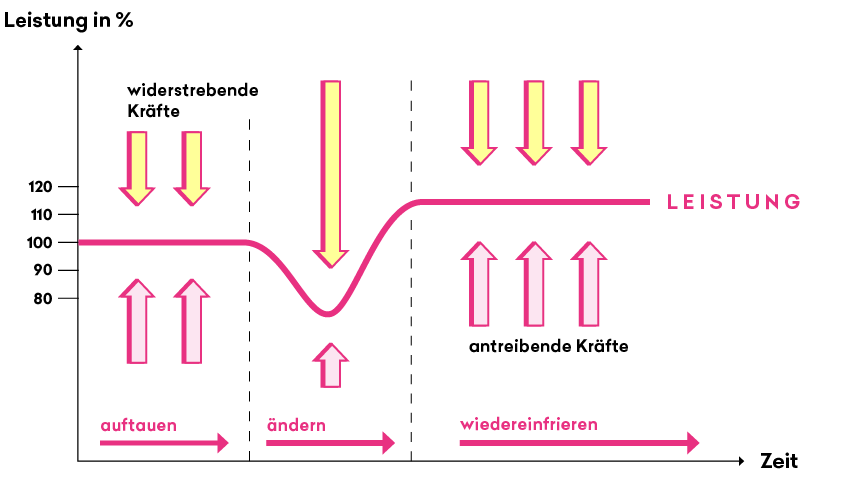
Kotter’s 8-step model
In his 8-step model, John P. Kotter focuses primarily on the people who are undergoing the change. He explores how change must take place in order to reduce resistance among managers and employees and build trust in the process.
The eight steps of Kotter’s model describe the individual steps or stages of the change process: from recognizing that change must take place, to involving everyone affected, to jointly implementing and stabilizing the change.
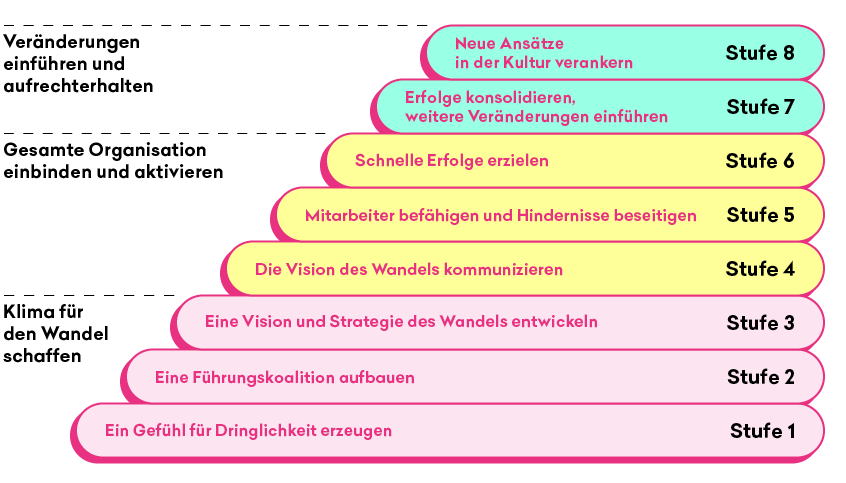
The change curve according to Kübler-Ross
Elisabeth Kübler-Ross is a well-known death researcher who developed the “5 stages of grief.” In fact, these five stages can also be reliably applied to change processes, as the model generally describes how people process change. By addressing the five stages (1. denial, 2. anger, 3. bargaining/negotiation, 4. depression, 5. emotional acceptance), organizations can better anticipate the reactions of their employees and respond appropriately.
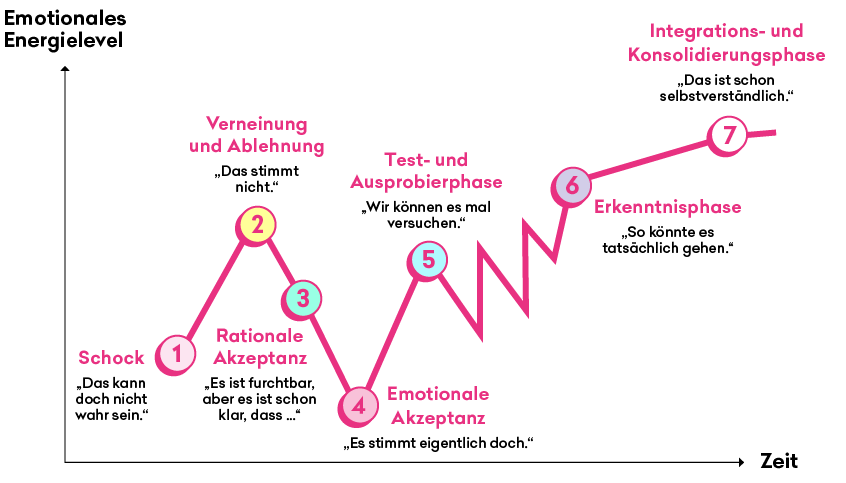
How does change management work?

Change management encompasses all activities, tasks, and measures necessary to bring about comprehensive and far-reaching change in an organization. Successful change processes often involve external consultants who not only have the necessary knowledge of change management, but also the required process expertise.
Whether new processes, structures, and/or strategies are actually implemented in a sustainable manner depends largely on how well this process is prepared and implemented:
The main task of change management is to plan, control, and monitor the respective individual steps in a strategically sensible manner before moving on to the stabilization phase. During the adjustment process, it is also the responsibility of those in charge to intervene in a targeted manner whenever the process stalls and/or threatens to exceed the time frame.
Change management – the process
From initial awareness of the problem to stabilization of the target state: Change processes are usually marked by a beginning and an end, have a specific goal, and can be divided into individual phases. Various methods and tools are used to implement the individual steps.
Awareness of shortcomings
Change usually arises from a shortcoming. Economic change processes also usually have a trigger, a reason for dissatisfaction with the status quo. This could be declining sales, reduced competitiveness, or dissatisfied employees.
Methods/tools that create this awareness of the problem often include competitor analysis, market research, or surveys within the organization. It is important to create a sense of urgency: Things cannot go on like this, we have to change something!
Problem analysis
Once you are aware of the problem, it is time to analyze it: What exactly are the problems and where do they arise? Are these problems something we can solve ourselves, or do we need an “outside perspective”? Methods/tools that are helpful in the analysis phase include process analysis and organizational analysis.
Formulation of the objective(s)
Once we know how and where the problems arise, we can formulate a target state. As this is one of the most critical phases in the change process, organizations should seek external support at this stage.
Change management specialists use various techniques to arrive at a meaningful target formulation. Among other things, this involves optimizing communication. Methods/tools used in this context include moderated conferences, strategy workshops, and conflict mediation.
Concept
Once the goals have been formulated, the concept follows: How exactly do we achieve our goal? What individual steps are necessary? What time frame are we talking about, what budget do we have available, who will play an important role in the change process (stakeholders)?
The methods/tools used here depend on the objectives and include moderated workshops, team and individual coaching, stakeholder analysis, and consulting on process optimization and project management.
Control
The change management process is only complete once the results have been evaluated: Was the goal achieved? Were there any setbacks? If so, what were the reasons for this?
Tools/methods available to measure the results include interviews with stakeholders and employee surveys. Often, a so-called evaluation catalog is created in advance, which is used as a basis for analyzing the results.
Change management – the phases
When it comes to change management, there is often talk of the “phases” of the change process. These phases do not describe individual strategic steps such as problem analysis or goal formulation, but rather reflect the emotional response of employees.
Employee leadership in change management
Since major changes in many organizations also bring about upheavals at the personnel level, dealing with negative reactions is an important part of change management. If fears, uncertainties, and other negative feelings are not managed well from the outset, the change will probably be over before it has really begun. For a change process to be successful, employees must be on board.
Managers therefore face a double challenge in change processes.
On the one hand, active leadership with a hands-on mentality is essential in the concrete change process: without strong leadership that communicates openly, does not withhold information, and has an open ear for fears and criticism, change processes can quickly stall.
On the other hand, in order to accompany and actively drive forward necessary change processes, managers must also increasingly “unlearn” things:
In the context of New Work and Digital Leadership, they are required to rethink “leadership,” engage with agile working methods, recognize trends, and deal with challenges innovatively.
The phases of change
In change management, we work with different models to map the phases that employees go through. The best-known models are Lewin’s very simplified 3-phase model and Kotter’s very detailed 8-step model (see above). In the following, we will use a simplified 5-phase model.

Rejection and denial
This can’t be true!
In many organizations, the announcement is followed by one thing above all else: shock. Rumors circulate, fears are voiced, and some people even start making plans to leave. Very few are open to the process.
In this situation, “good leadership” means not withholding information, creating opportunities for exchange, and showing understanding. At the same time, however, it is important not to water down the message: change is coming.

Resistance and negotiation
I’m not going along with that!
The shock is followed by backlash. Resistance can range from attempts at negotiation (“That’s not going to work.”) to open refusal to work, threats of resignation, and outright termination.
Now it is important not to ignore the criticism of employees. Managers should find out exactly what is behind the rejection (e.g., fear of losing status) and definitely discuss counterproposals. Threatening consequences should always be a last resort.

Grief and depression
That’s just awful!
If management remains true to its line, denial is followed by the realization that change is coming. For employees, this realization often means a loss that must be mourned. In this context, we often refer to the valley of tears.
During this phase, organizations should create opportunities for exchange and ideally also offer professional support, e.g., through supervision and group or individual coaching. It is important that employees are not left alone with their feelings of anger and grief.
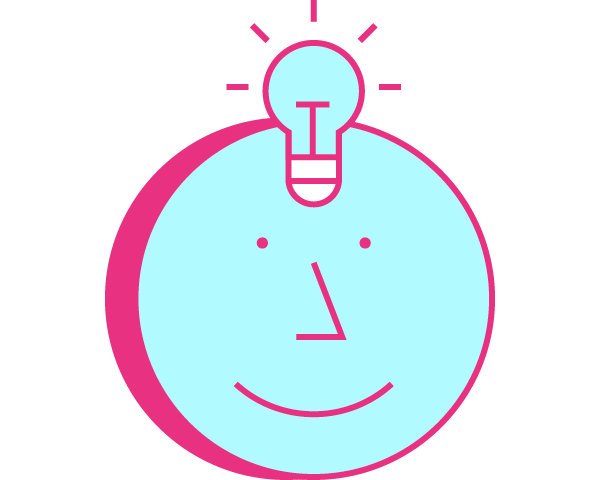
Trying out and discovering
Maybe it’s not so bad after all…
The sadness is followed by the rational realization that change is inevitable. At this point, most employees will still be mourning the loss of their old ways, but they will also be cautiously testing the waters for the future: What does this change mean for me? Where is my place in the new structure?
In this time of uncertainty, good leadership provides support and shows the way forward. Now it is important to remain open-minded, highlight opportunities and prospects, communicate (partial) successes, and recognize achievements. Short-term successes are a good way to keep employees “on board.”

Acceptance and commitment
I can give it a try.
Once the old has been properly mourned, space for the new emerges: (Most) employees can now come to terms with the change and are ready to learn new things and put them into practice: They give change a chance.
For management, NOW is the time to align individual performance goals with the company’s target state. At the same time, it is important to show employees their development potential within the new structures, to enable support, and to recognize achievements.
Change management with Wonderwerk

Wonderwerk Consulting has been successfully supporting change processes for many years. We provide the necessary outside perspective and are specialists in the process behind change: we not only know how change works in theory, but are also familiar with all the practical hurdles that stand in the way of sustainable change in most organizations.
In order to successfully guide you through the change, we first want to understand how your company currently works and what challenges you are facing.
Based on these prerequisites, we work with you to formulate your new target state, develop a concept, and plan its implementation in terms of strategy, timing, and budget. We support you in
- Formulating your goals in a realistic and concrete manner.
- Achieving your target state more quickly and smoothly.
- Identifying the key people (stakeholders) for the change and gaining their support.
- Anticipate all types of reactions and respond appropriately.
- Optimize your communication regarding objectives and measures to see results faster.
- Focus your energy on the right measures.
- Stabilize the target state.
Transformation through innovation
In many companies, the shortfall is noticeable, but there is no solution in sight: You know that the demands of your customers or the users of your products have changed, but you don’t know how to meet these demands: After all, the resources have remained the same or are even decreasing. As professionals in innovation management and future(s) thinking, we are happy to support you in breaking new ground. Our focus is always on the people who shape your company: under our guidance, your employees become a source of new ideas and concepts (more about our services).
Why Wonderwerk?
Because we think beyond the process. Our consultants’ work does not end when the change has been implemented. Only when the new state has become the norm in your organization have we achieved our goal.
Contact
Thomas Klein
office@wonderwerk.com
Book your free consultation now!
Our change management trainings

New Work

New Leadership

Agile methods

Trend management


